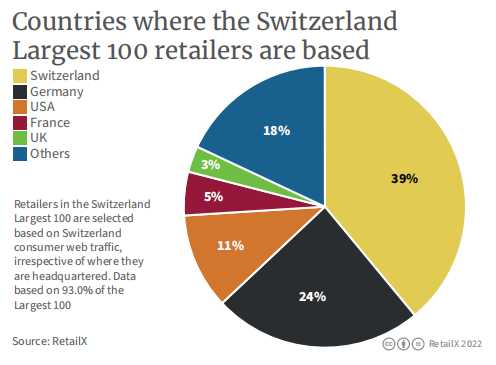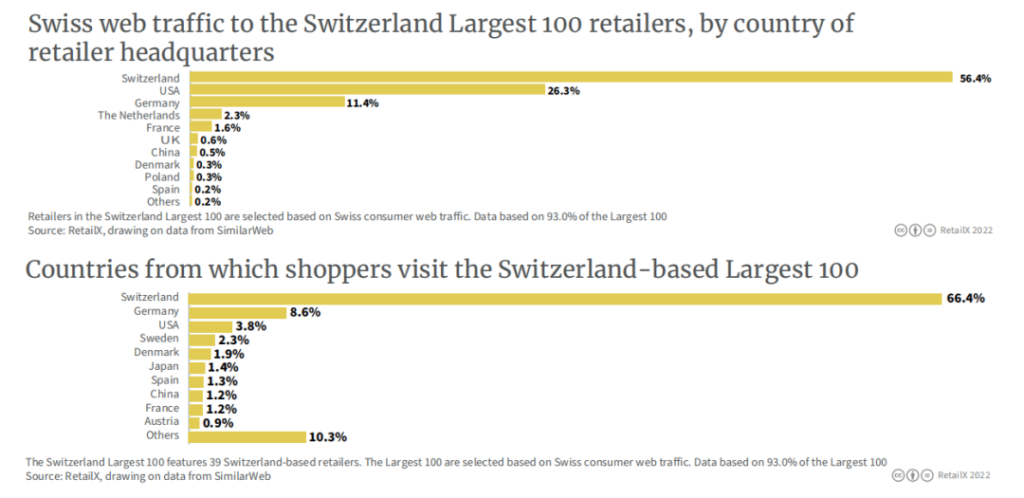Schweizer E-Commerce-Marktübersicht
Die Schweiz befindet
Konferenz über Handel und Entwicklung (UNCTAD). Der Gesamtumsatz von E-Commerce in der Schweiz wird voraussichtlich bis 2025 24 Milliarden Euro erreichen. Im Jahr 2021 wird die Gesamtzahl der Online-Käufer in der Schweiz rund 6 Millionen beträgt. In Bezug auf den Umsatz liegt die Modekategorie in den wichtigsten Kategorien an erster Stelle und wird voraussichtlich bis 2025 auf 7 Milliarden Euro steigen. Die Möbelkategorie belegt den zweiten Platz. Die Einnahmen werden voraussichtlich im Jahr 2025 auf 5 Milliarden Euro steigen.
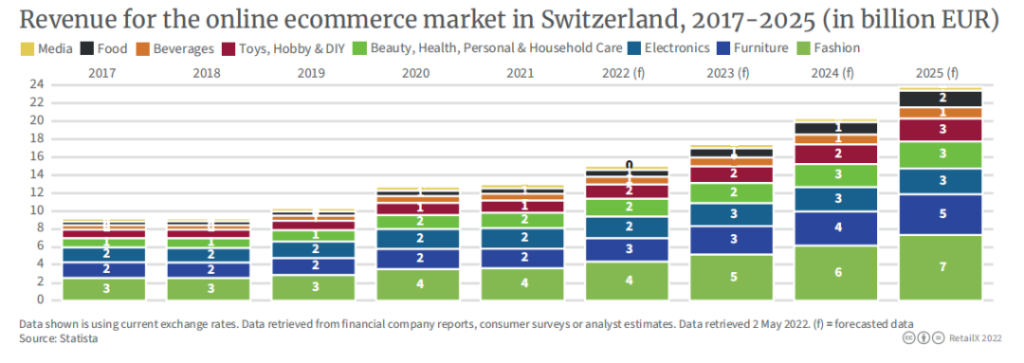
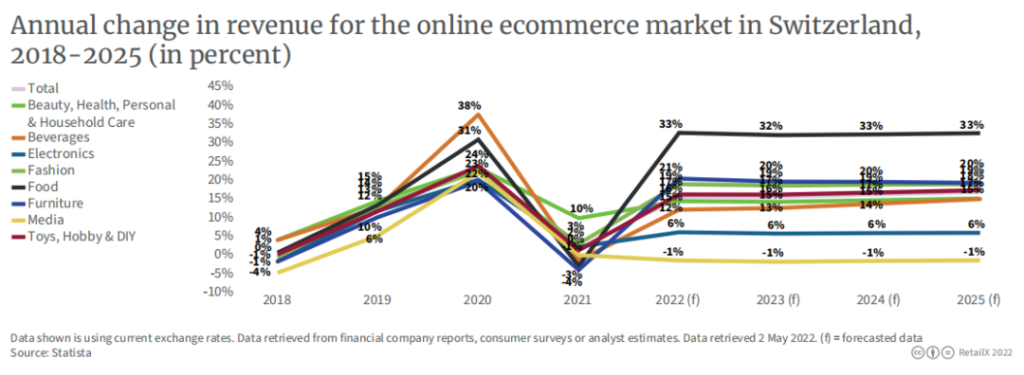
Konzentrieren Sie sich auf lokale Markttrends in der Schweiz
· Verbraucher
Im Jahr 2017 bevorzugten nur 11% der Befragten Online -Shopping. Im Jahr 2022 wird dieser Anteil voraussichtlich auf 22% steigen, und dieser Anteil wird in Zukunft weiter steigen, und es wird voraussichtlich im Jahr 2025 auf 27% steigen. Aufgrund der Prämisse, dass die Bevölkerungsstruktur und die Gesamtbevölkerung der Schweiz nicht stark schwanken, wird die Gesamtzahl der Online -Einkaufsbevölkerung von Jahr für Jahr zunehmen.
Die Gesamtzahl der Nutzer von elektronischen Produkten ist in den letzten fünf Jahren von 3 auf 5 Millionen gestiegen und wird voraussichtlich bis 2025 6 Millionen erreichen. Die Zahl der Online -Käufer in der Modekategorie wird voraussichtlich von 3 Millionen im Jahr 2017 auf 5 Millionen in den nächsten drei Jahren in den nächsten drei Jahren erwartet.
Aus der Sicht der Altersgruppe befinden sich etwa 70% der Online-Käufer im Alter von 25 bis 54 Jahren, und die Proportionen der drei Altersbereiche von 25 bis 34 Jahren, 35-44 Jahre alt und 45-54 Jahre alt sind sehr eng. Die beiden Altersgruppen von 18-24 und 55-64 haben die kleinsten Proportionen.
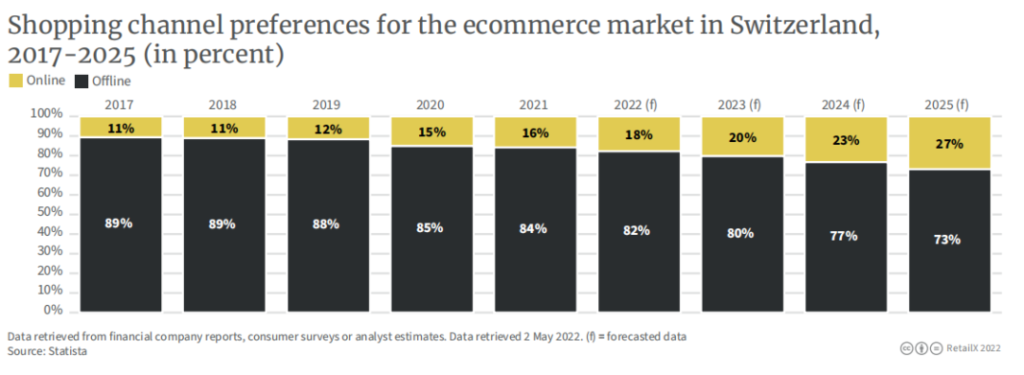
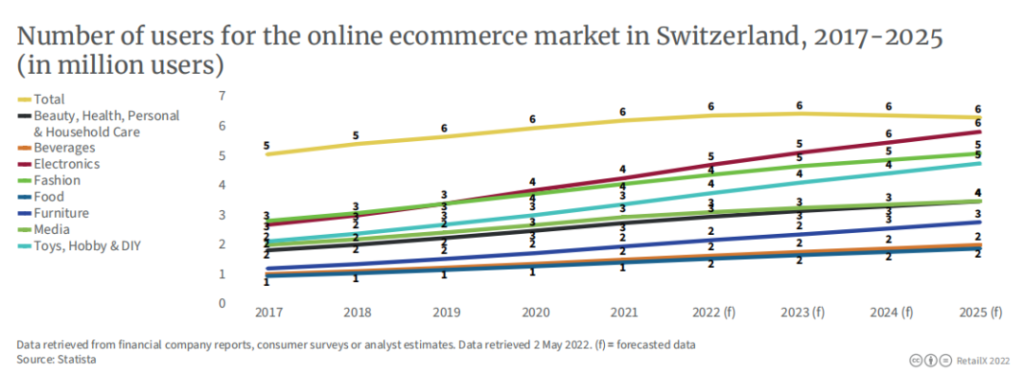
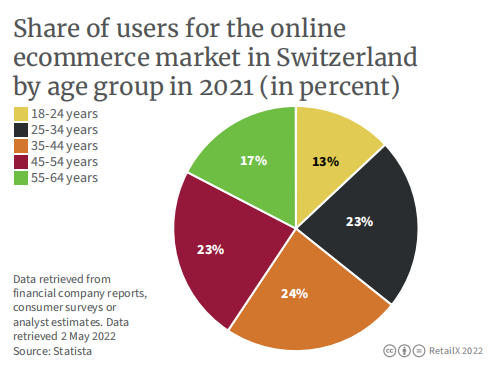
In Bezug auf die Einkaufsgewohnheiten sind die Internetnutzer in Großbritannien und der Schweiz sehr ähnlich. Die Unterschiede konzentrieren sich hauptsächlich auf Online -Bestellung und Offline -Abholung. 46% der Briten haben diese Einkaufsgewohnheit, während in der Schweiz der Anteil nur 37% beträgt. Die beiden Länder zeigen auch eine hohe Ähnlichkeit in Bezug auf Online -Einkaufsgeräte. Großbritannien hat einen höheren Anteil an Smartphones, Tablets, Smart -TVs und intelligenten Lautsprechern, während die Schweiz auf Desktop -Computern deutlicher ist. Der Anteil der Nutzung ist 9% höher als der Großbritanniens.
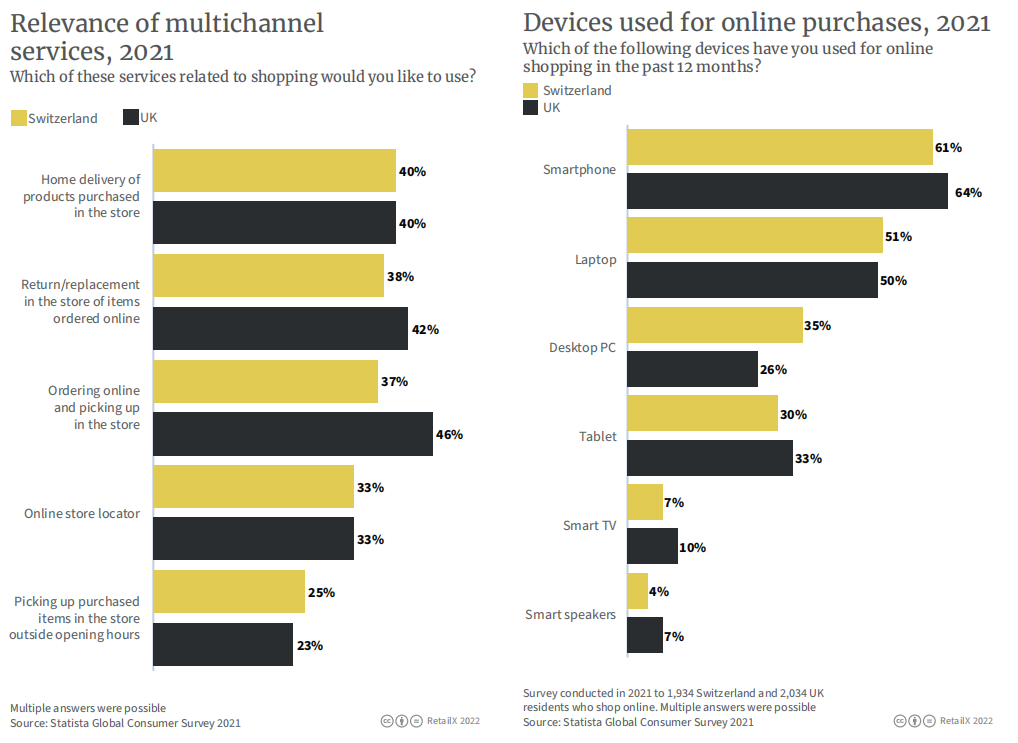
· Sea Rush
Deutschland, der größte Handelspartner der Schweiz, ist auch der Ursprung von 40% der Einkaufsprodukte der Schweizer aus Übersee. Die zweitgrößte Handelspartnerin der Schweiz sind die Vereinigten Staaten, gefolgt von Großbritannien, China und Frankreich. Die Beziehung zwischen China und den Vereinigten Staaten ist jedoch eine gegenseitige Qualität, wenn sie auf die Quelle der Waren zurückzuführen ist. Der 26 -prozentige Anteil Chinas ist mehr als verdreifacht die 7 Prozent der USA. Laut einem im Jahr 2020 veröffentlichten Blog -Beitrag verfügen 80% der Schweizer, die online einkaufen, mindestens ein Einkaufserlebnis in Übersee. Die meisten befragten Schweizer sagten, dass die meisten Produkte, die bei Einkäufen in Übersee gekauft wurden, Produkte sind, die in der Schweiz schwer zu finden sind.
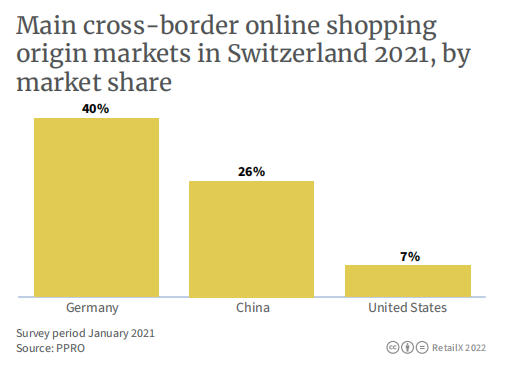
Aus geografischer Sicht befindet sich die Schweiz mitten in Europa und grenzt in Deutschland im Norden. Schweizer Menschen gehen oft zum Einkaufen nach Deutschland, da deutsche Produkte erschwinglicher sind und Steuerrabatte verfügbar sind. Besonders um Weihnachten wird die Schweizer den Urlaub nutzen “Einkaufen” In Deutschland und der Aufstieg des Online -Einkaufs hat diesen Prozess stark vereinfacht. Jetzt kann die Schweizer lokale Produkte kaufen, ohne das Haus zu verlassen. Seltenes Zeug”.
Bereits 2016 waren die Schweizer Hersteller besorgt, dass lokale hochwertige Inlandsprodukte sein würden “zu Tode gesaugt” durch diese fremden Gegenstände. Obwohl die Schweizer nationale Gefühle für inländische Produkte haben, wissen sie auch, dass die Qualität der Einkaufsprodukte in Übersee inländischen Produkten, sogar gefälschte OEM-Produkte, weit unterlegen ist, aber möglicherweise aufgrund der Auswirkungen des wirtschaftlichen Abschwungs, der Schweiz, die von der Kosteneffizienz überzeugt ist, wählt das Einkaufen in Übersee. Die Zahl der Menschen steigt von Jahr zu Jahr.
Im Prinzip müssen Schweizer Zollaufgaben und Schweizer Mehrwertsteuer für Produkte aus dem Ausland bezahlt. Die Schweizer Behörden wiesen jedoch auch darauf hin, dass die Pflichten und die Mehrwertsteuer unter CHF 5 nicht in Rechnung gestellt werden. Daher sind Bestellungen bis zu CHF 200 (einschließlich Verpackungs- und Liefergebühren) von Aufgaben und Mehrwertsteuer befreit.
·Zahlen
Ein Bericht des European Payments Council zeigt, dass die Schweizer es vorziehen, Bargeld als Zahlungsmittel aufgrund des Schutzes der Privatsphäre zu verwenden. Mit der Entstehung von bequemeren Zahlungsmethoden wie elektronischen Geldbörsen und Bankübertragungen ist die Verwendung von Bargeld in der Schweiz jedoch im Abwärtstrend. Interessanterweise zeigen Statistiken, dass die Verbreitung von Bargeld auf dem Markt in den frühen Tagen des Ausbruchs im Jahr 2020 tatsächlich zugenommen hat, was bedeutet, dass die Schweizer immer noch von Bargeld besessen sind und es als Möglichkeit verwenden, in Krisenzeiten zu sparen.
Derzeit hat die Schweiz keine Pläne, digitale Währung einzuführen, aber in Bezug auf Zahlungsmethoden zeigt die Absichtserhebung, dass nur 2% der Schweizer Barzahlungen bevorzugen.
In der Schweiz machen Banktransfers 56%, Kredit- oder Debitkartenzahlungen zu 25%, gefolgt von E-Wallets (einschließlich Apps wie PayPal, Apple Pay und Google Pay) zu 16%. Die Schweizer haben die Gewohnheit des Finanzmanagements. Websites oder Blogs wie “Die armen Schweizer” Lernt, wie man Geld verdient, z. B. welche Kreditkarten nach der Verwendung von Cash -Back zurückbekommen und welche Plattformen nur die Abrechnung in Euro oder Dollar unterstützen. Es ist kostengünstiger, mit Kreditkarten zu bezahlen.
Zusätzlich zu den mangelnden wirtschaftlichen Vorteilen für Verbraucher gibt es einen weiteren Grund für die geringe Nutzungsrate elektronischer Geldbörsen. In dem Switch-Cert berichtet, dass die Beamten allein im August 2017 4.500 gefälschte Websites, die mit dem Schweizer Domainnamen enden, mit tiefen Rabatten oder Werbegeschenken lockten, aber entweder die Waren sind nicht auf der richtigen Board, oder die Qualität ist äußerst schlecht und hat überhaupt keinen Wertverkehrswert, und es wird von Fachabaud verdächtigt. Nach dem Ausbruch der Epidemie ist das Problem der Phishing -Websites wieder aufgetaucht. Aus Angst vor betrügerischem Verhalten wählen einige Verbraucher immer noch Bargeld für die Lieferung.
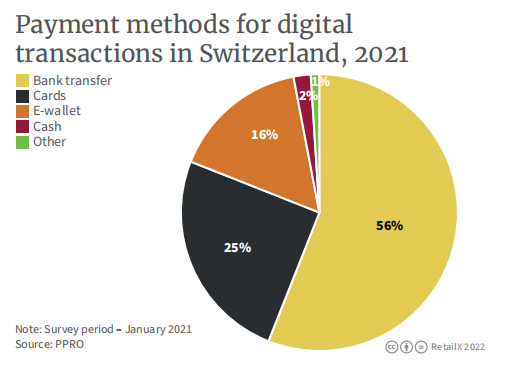
· Verbrauchergewohnheiten
Bereits 2015 wurde die Schweiz von Datenforschungsinstitutionen als eines der Länder mit dem größten E-Commerce-Markt in Europa in der Zukunft angesehen. Fast zehn Jahre später zeigen Daten, die im April 2022 von Dynamic Paket Distribution veröffentlicht wurden, dass sich die Schweizer Verbrauchsgewohnheiten aufgrund der Epidemie stark verändert haben. Die Anzahl der Online -Einkaufsmöglichkeiten in der Schweiz ist seit 2017 stetig zugenommen. Die Prognose für 2022 beträgt 2.343 Euro und stieg im Jahr 2025 auf 3.753 Euro.
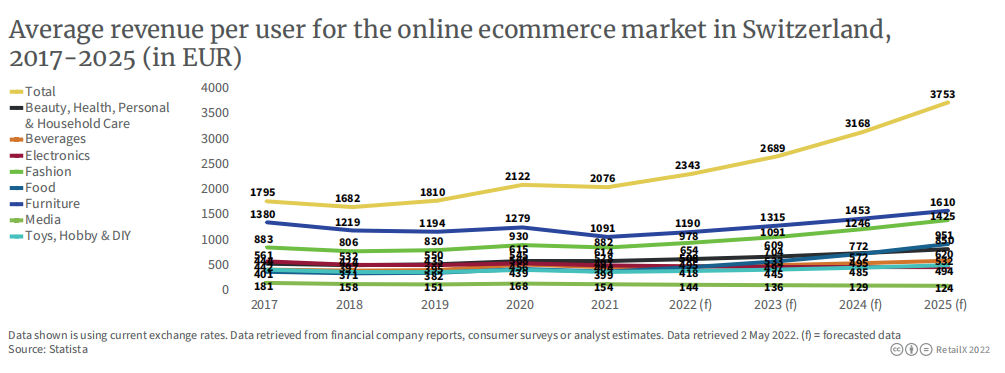
Wie aus der folgenden Abbildung hervorgeht, wird der Verbrauch der beliebten Online-Einkaufskategorien im Jahr 2021 hauptsächlich von den drei Altersgruppen von 25-34, 35-44 und 45-54 angetrieben. Unter ihnen geben Verbraucher im Alter von 35 bis 44 Jahren am meisten für Sport aus & Outdoor-Produkte, die 30%und die Verbraucher im Alter von 18 bis 24 Jahren am wenigsten für Lebensmittel ausgeben & Getränke, die nur 7%ausmachen.
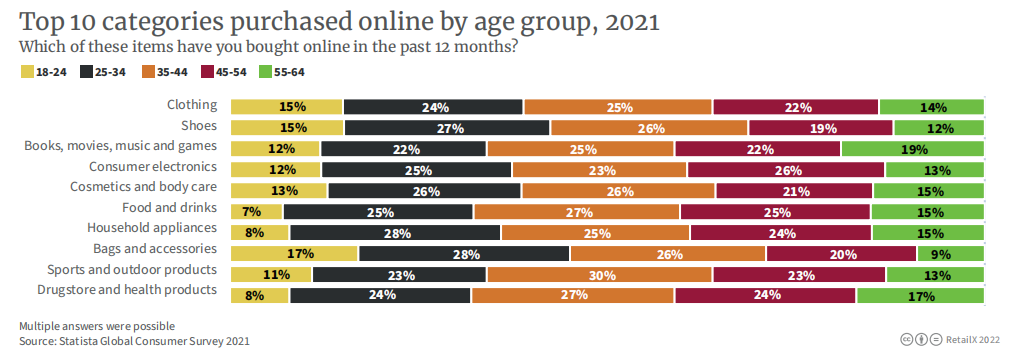
Daten aus mehreren Kanälen zeigen, dass die Schweizer immer noch eine Schwäche für computergestützte Online-Einkaufsmöglichkeiten haben und das Transaktionsvolumen sogar das der mobilen Geräte verdoppelt. In Zukunft wird der Anteil der Online -Einkäufe auf mobilen Geräten von Jahr zu Jahr steigen, und es wird voraussichtlich bis 2025 auf 35% steigen.
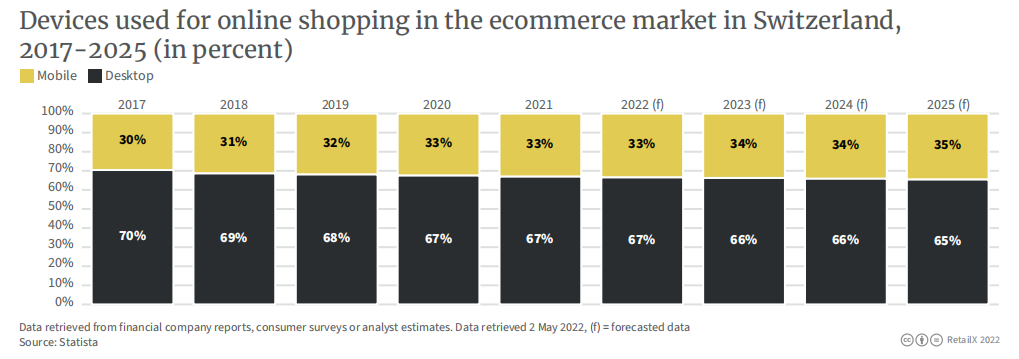
Die Befragten in der Schweiz und im Vereinigten Königreich hatten etwas andere Bedenken, als sie gefragt wurden, welche Kategorien sie besonders auf Preissenkungen achten würden. Die Schweizer sind mehr besorgt darüber, die Preise für Schuhe, Kleidung und Reinigung von Produkten zu senken, während die Briten mehr mit Schreibwaren und Hobbyprodukten besorgt sind. Laut der Umfrage liegt der Preis in den Augen des Schweizer zweitens an den Herkunftsort.
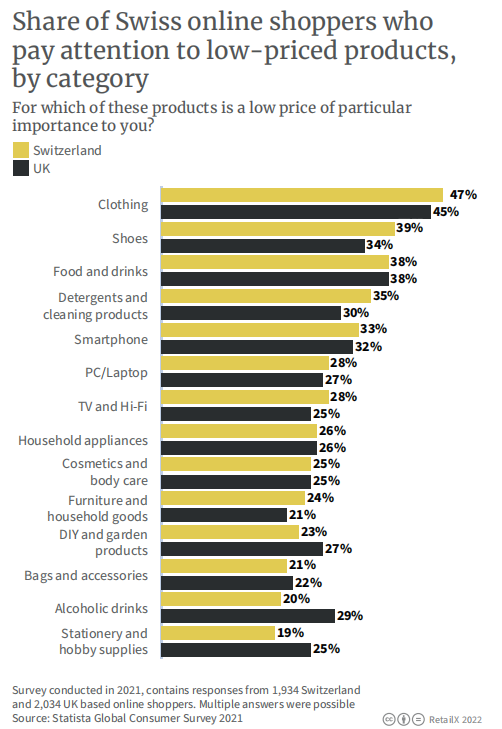
Die Gesamtdurchdringung von E-Commerce in der Schweiz wird voraussichtlich zwischen 2023 und 2025 leicht abnehmen, von 73% auf 71%. Die E-Commerce-Penetrationsrate einzelner Kategorien hat jedoch zugenommen. Zum Beispiel wird die Penetrationsrate der elektronischen Produkte voraussichtlich bis 2025 auf 66% steigen, und die E-Commerce-Penetrationsrate von Mode, Spielzeug & Hobbys & DIY -Kategorien werden bis 2025 ebenfalls stark erreichen. Wachstum auf mehr als 50%.
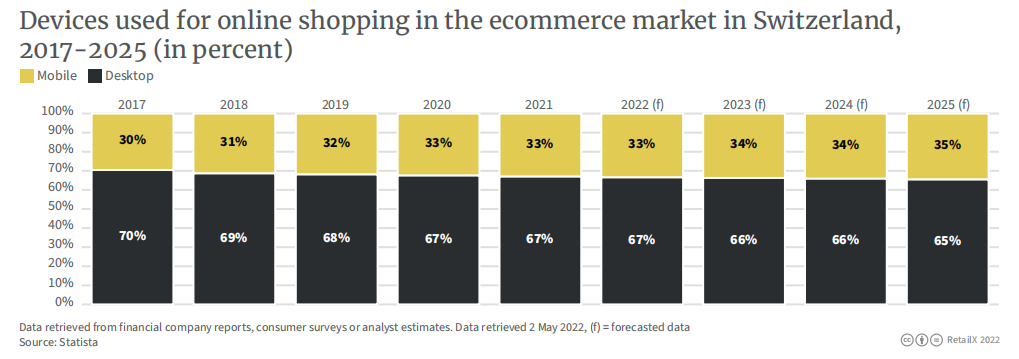
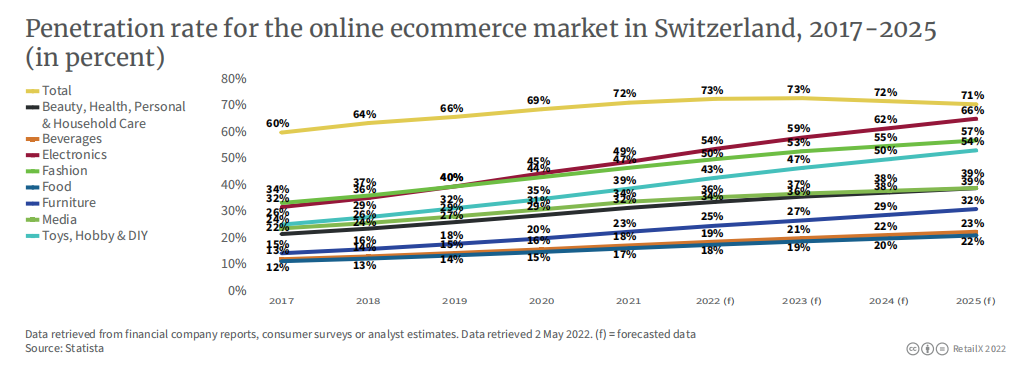
·Logistik
Overall, the return rate for online shopping in Switzerland is lower than in the UK. In 2021, 45% of respondents in Switzerland said they did not have any returns, compared with 54% in the UK. It can be seen from the data chart that the return rate of shoes and clothing and bags is relatively high, especially the proportion of shoes and clothing.
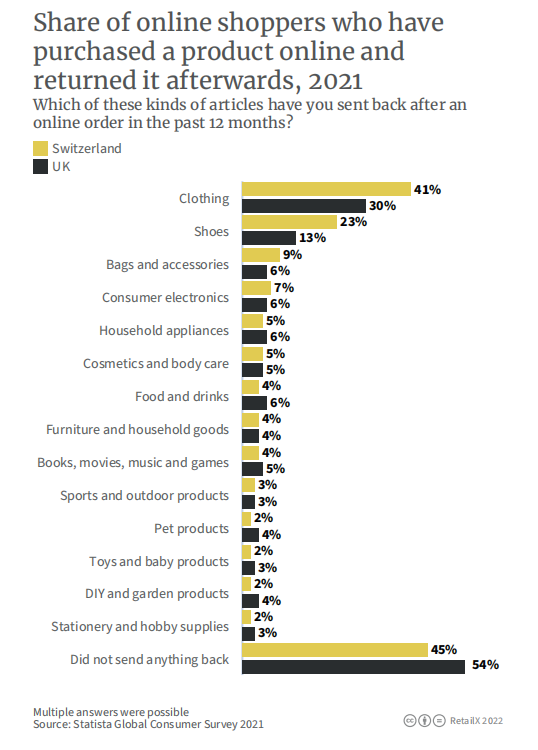
According to the data, the parcel transportation volume of Swiss Post showed a steady upward trend from 2017 to 2019, and it rose sharply in 2019, and this trend has continued in the next few years.

Im Jahr 2020 umfassten die Logistikdienste von Swiss Post 400.000 Haushalte in 1.788 Städten, hauptsächlich in ländlichen Gebieten.
In der Schweiz ist das Senden von Gegenständen nach Paket ein typisch effizienter Prozess. Mit der Swiss Post können Benutzer zu Hause Etiketten drucken und das Porto bezahlen, wenn der Artikel an die örtliche Post geliefert wird. Benutzer können einen Rabatt von 15% bei der Verwendung des “Inlandspaketetikett” Service online oder am my post 24 terminal. Darüber hinaus gibt es dedizierte Servicespuren für sperrige Waren, gefährliche Waren, Möbel und elektrische Geräte sowie Produkte, die von Farmen ausgeliefert werden. Zu den anerkannten Zahlungsmethoden gehören Postfinanzkarten und Schweizer Zahlung App Twint.
Das laufende Projekt von Swiss Post (CST) -Projekt von Cargo Sous Terrain (CST) zielt darauf ab, Waren durch ein System von unterirdischen Hubs zu transportieren und das Logistiknetz von Großstädten wie Genf, Bern, Basel und Zürich zu eröffnen.
· Nachhaltige Wirtschaft
In addition to agricultural resources and freshwater reserves, Switzerland’s own resources can be described as scarce. Marcel Meyer of Deloitte Switzerland said in 2021 that the future development of Switzerland needs to be tied to the concept of sustainability, and companies should uphold the long-term philosophy of coexisting and co-governing with the earth. Similar to neighboring Austria and Germany, the consumption of sustainable products in Switzerland is continuing to rise, but there is still a long way to go in terms of product packaging and iteration of logistics methods.
Consumer research in Switzerland shows that 53% of respondents are ready to send back reusable packaging, while only 9% say they are not prepared to compromise on sustainability.
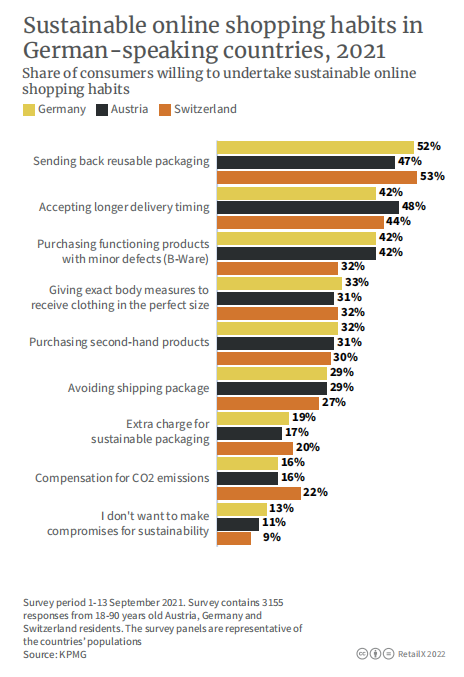
· Lokale Top -100 -Einzelhändler
Die 100 besten Einzelhändler in der Schweiz zeigten keine ähnliche Konzentration wie in anderen Ländern. Die Einzelhändler in der Schweiz machten nur 39% aus, und die Einzelhändler in Deutschland und die Vereinigten Staaten machten 24% bzw. 11% aus. Darüber hinaus machte der Verkehr von Einzelhändlern in der Schweiz 56,4%, gefolgt von den Vereinigten Staaten und Deutschland. In der Liste der am häufigsten besuchten Swiss -Einzelhändler -Websites sind die USA und Deutschland ebenfalls hoch.
